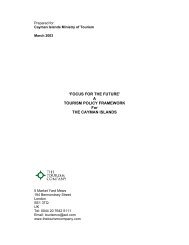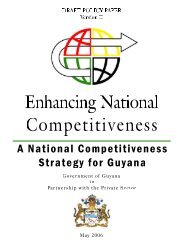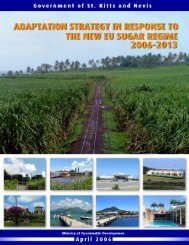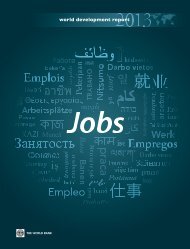Business Removing
Doing Business in 2005 -- Removing Obstacles to Growth
Doing Business in 2005 -- Removing Obstacles to Growth
- No tags were found...
Create successful ePaper yourself
Turn your PDF publications into a flip-book with our unique Google optimized e-Paper software.
82 DOING BUSINESS IN 2005<br />
imum duration of term contracts; and (iii) the ratio of the<br />
mandated minimum wage (or apprentice wage, if available)<br />
to the average value-added per working population. A country<br />
is assigned a score of 1 if term contracts can only be used<br />
for temporary tasks, and a score of 0 if term contracts can be<br />
used for any task. A score of 1 is assigned if the duration of<br />
term contracts is 3 years or less; 0.5 if the duration is between<br />
3 and 5 years; and 0 if term contracts can last more than 5<br />
years. Finally, a score of 1 is assigned if the ratio of minimum<br />
wage to average value added per worker ratio is higher than<br />
0.75; 0.67 for ratios between 0.50 and 0.75; 0.33 for ratios between<br />
0.25 and 0.50; and a score of 0 if the ratio is below 0.25.<br />
For example, term contracts are only allowed for temporary<br />
tasks in Uruguay (a score of 1), but they can be longer than 5<br />
years (a score of 0), and the ratio of the mandated minimum<br />
wage to the value-added per worker in 0.10 (also a score of 0).<br />
Averaging the three subindices and scaling the index to 100<br />
gives Uruguay a score of 33.<br />
The Rigidity of Hours index has 5 components: (i) whether<br />
night work is restricted; (ii) whether weekend work is allowed;<br />
(iii) whether the workweek consists of 51⁄2 days or<br />
more; (iv) whether the workday can extend to 12 hours or<br />
more (including overtime); and (v) whether the annual paid<br />
vacation days are 21 days or less. If the answer to any of these<br />
questions is no, the country is assigned a score of 1, otherwise<br />
a score of 0 is assigned. For example, night work is not allowed<br />
in Vietnam (a score of 1), weekend work is restricted (a<br />
score of 1), the workday—with overtime—can extend to 12<br />
hours (a score of 0), 6-day work weeks are allowed (a score of<br />
0), and paid vacation is 16 days (a score of 0). The scores are<br />
then summed and scaled to 100 to get to the final index of 40<br />
for Vietnam.<br />
The Difficulty of Firing index has 8 components:<br />
(i) whether redundancy is not grounds for dismissal;<br />
(ii) whether the employer needs to notify the labor union or<br />
the labor ministry for firing 1 redundant worker; (iii)<br />
whether the employer needs to notify the labor union or the<br />
labor ministry for group dismissals; (iv) whether the employer<br />
needs approval from the labor union or the labor ministry<br />
for firing 1 redundant worker; (v) whether the employer<br />
needs approval from the labor union or the labor ministry for<br />
group dismissals; (vi) whether the law mandates training or<br />
replacement prior to dismissal; (vii) whether priority rules<br />
apply for dismissals; and (viii) whether priority rules apply<br />
for reemployment. If the answer to any question is yes, a score<br />
of 1 is assigned, otherwise a score of 0 is given. Questions (i)<br />
and (iv), as the most restrictive regulations, have doubleweight<br />
in the construction of the index. For example, an employer<br />
in Brazil has to both notify (a score of 1) and seek approval<br />
(a score of 2) from third parties when dismissing a<br />
redundant worker, she has to both notify (a score of 1) and<br />
seek approval (a score of 1) when dismissing a group of<br />
workers, and redundancy is not considered a fair grounds for<br />
dismissal (a score of 2). The law does not mandate priority<br />
rules for dismissal (a score of 0) or reemployment (a score of<br />
0), and there is no requirement for retraining or alternative<br />
placement prior to dismissal (a score of 0). Adding up and<br />
scaling to 100 gives the final index of 70 for Brazil.<br />
The Cost of Firing indicator measures the cost of advance notice<br />
requirements, severance payments and penalties due<br />
when firing a worker, expressed in terms of weekly wages. For<br />
example, in Cameroon an employer is required to give 16<br />
weeks advance notice prior to a redundancy dismissal, the<br />
severance pay for workers with 20 years of experience equals<br />
7 months of wages, and redundancy is grounds for dismissal<br />
so no penalty is levied. Altogether, the employer pays the<br />
equivalent of 46 weeks of salary to dismiss the worker.<br />
This methodology is originally developed in Botero and others<br />
(forthcoming) and adopted with minor changes here.<br />
Registering property<br />
A business purchases land and a building in a peri-urban area<br />
of the most populous city. Doing <strong>Business</strong> covers the full sequence<br />
of procedures necessary to transfer the property title<br />
from the seller to the buyer. Every required procedure is included,<br />
whether it is the responsibility of the seller, the buyer,<br />
or where it is required to be completed by a third party on<br />
their behalf.<br />
Local property lawyers and property registries provide information<br />
on required procedures, as well as the time and the<br />
cost to fulfill each of them. In most countries, the data are<br />
based on responses by both lawyers and officials in the property<br />
registries.<br />
Assumptions about the business<br />
To make the business comparable across countries, five assumptions<br />
are employed. The business:<br />
• Is a limited liability company.<br />
• Is located in a peri-urban area of the country’s most populous<br />
city.<br />
• Is 100% domestically and privately owned (no foreign or<br />
state ownership).<br />
• Employs 50 employees, all of whom are nationals.<br />
• Operates in general commercial activities.

















